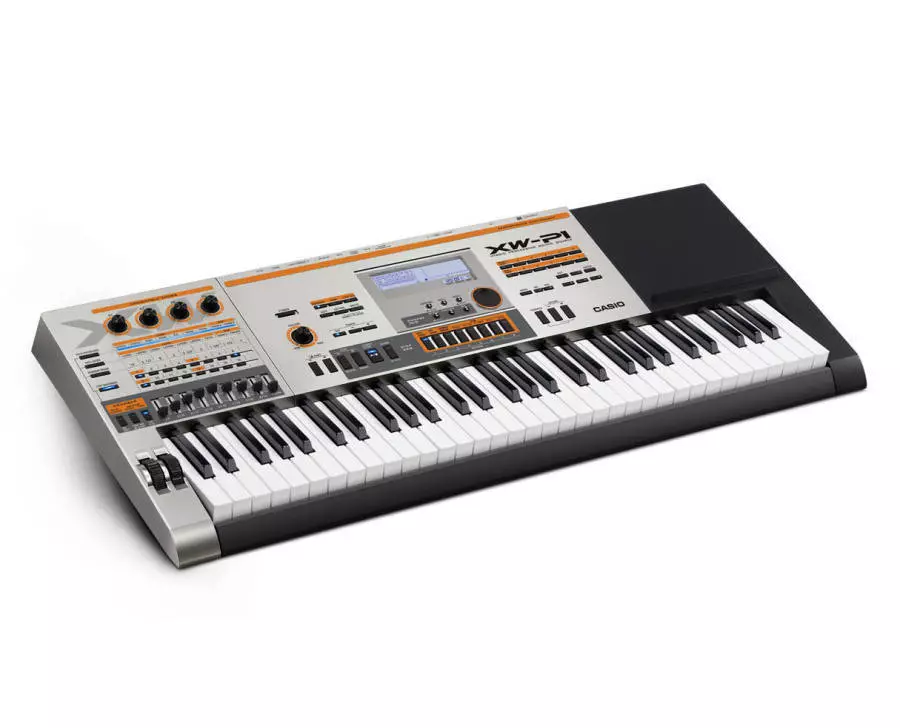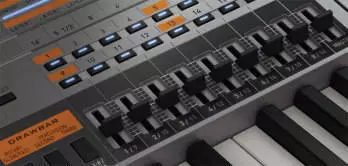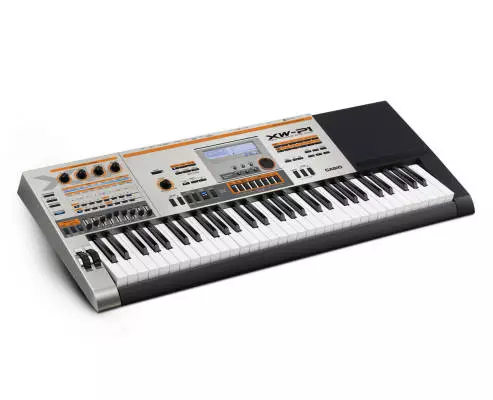The XW-P1 is a 61 key performance synthesizer with Casio's exclusive (HPSS) Hybrid Processing Sound Source. Providing screaming virtual analog monophonic leads and basses, drawbar organs, complex layers, stereo pianos, drums and more, the XW-P1 has the sounds and real-time control the performing musician needs.
- 6 Oscillator Monophonic Solo Synthesizer
- HexLayer A single sound made up of 6 components for gig ready splits and layers
- Drawbar Organ Mode with 9 sliders, adjustable rotary speaker, key click, vibrato and percussion
- 400 fully editable PCM based sounds like stereo pianos, vintage electric pianos, strings, guitars, drums and more
- Step Sequencer with 9 instrument tracks and 4 controller tracks
- 16 step programmable Arpeggiator
- Phrase sequencer to record and playback your riffs
- Performance mode providing 4 internal or external instrument zones with instant recall of effects, Step Sequences, Arpeggiators and Phrases
- 4 real-time controller knobs
- Pitch and Modulation Wheels
- 1/4 Mic and Line puts to process your voice or other instruments
- Stereo 1/8 line input to connect an MP3 player, laptop or tablet
- USB and MIDI ports
- 1/4 Line Outputs
- Included Power Supply
- Can operate on 6 D batteries
There are currently no questions for this product.
3.15.7.155
Mozilla/5.0 AppleWebKit/537.36 (KHTML, like Gecko; compatible; ClaudeBot/1.0;
[email protected])
Don't dismiss it due to "brand name". I highly reccomend this "underdog"! 1 of 1 customers found this review helpful
Features
Quality
Value
Overall
Product Experience I own it
Closest Store Abbotsford, British Columbia
Back in the 80's, I too, was guilty of writing off Casio for making mostly cheap toy, novelty keyboards. I never tried any of their more professional models because of this. Pity, because I might have bought one sooner.
Well, almost 20 years later, they have released a very capable, synth that is ridiculously inexpensive considering it's capabilities and features. Shame that L&M don't keep these "in store" because I am positive they would sell themselves.Posted by anonymous on Jan 3, 2014
Was this review helpful? Vote helpful Vote not helpful flag this review
Great keyboard for the price 0 of 0 customers found this review helpful
Features
Quality
Value
Overall
Product Experience I own it
Closest Store Mississauga, Ontario
I am learning synth and bought this board. It is packed full of features, and you won't find a lower price unless you buy used. Some of the sounds are retro, but that's part of the reason I bought it. Superb bang for the buck.Posted by Peter on Dec 9, 2013
Was this review helpful? Vote helpful Vote not helpful flag this review
Don't be a snob 0 of 0 customers found this review helpful
Features
Quality
Value
Overall
Product Experience I own it
Closest Store Waterloo, Ontario
I know what you're thinking. It's a Casio and it's pretty inexpensive. (In fact, it's currently the least expensive keyboard synthesizer L&M carries). So it just can't be any good. But you'd be wrong. While it doesn't seriously challenge a synth costing a few thousand dollars it can easily hold its own with models costing twice as much. And its particular unique mix of features might be useful to you even if you already own the heavyweight gear.
Let's start with those features. It's a 64-voice machine with four different sound engines: PCM, Drawbar Organ, Hex Layer and Solo Synthesizer. The PCM (ROMpler) side is okay - nothing to write home about but useable for the most part (there are, as always with any ROMpler, a few tones that stinketh like Limberger cheese). The drawbar organ emulation is useable, especially if you add an outboard Leslie simulator (the internal one is not particularly convincing).
Hex Layer is the P1's fully polyphonic synth engine. It allows you to use up to six PCM waves in various combinations, including velocity switching. This is more than just layering of tones from the PCM engine because you get more extensive control of the envelopes when you access the underlying waves. Unfortunately, what you do NOT get in this mode is an envelope-controlled resonant filter. The filter you do get for each layer is a simple, static tone control. While you might think this would be limiting, the pool of 789 waves you can access, most of them multi-sampled, does include components that can be used to create what to the ear sound just like resonant filter sweeps. Resonant filter or not, the P1 Hex Layer excels at creating spacey, ethereal pad sounds.
The P1's monophonic "Solo Synthesizer" engine, which is identical in the XW-G1 version, is where Casio's engineers went to town. It is based on the typical subtractive synthesis VCO-VCF-VCA signal chain but gets far more complex. Whereas a typical virtual-analog synth offers two or three oscillators plus a noise source the XW has four oscillators and a noise source. It can also process an external audio source input on line-level or microphone inputs as an extra "oscillator." Besides passing the external audio through filters and effects, it can be pitch shifted over the range of the keyboard. This unusual capability is just begging to be used creatively.
All of the solo synthesizer's oscillators have their own, dedicated, virtual filters and amplifiers controlled by independent envelopes. All except noise also have independent envelopes for pitch control as well as independent portamentos. There are two well-appointed LFOs. All the oscillators feed a multi-mode, four-pole resonant filter and an effects block. There is also an eight-slot modulation matrix with over one hundred sources and well over 300 destination parameters. Clearly, the solo synth engine is deep!
Does the solo synthesizer engine sound like a real analog monophonic model? Of course not. Does it sound like a high-quality virtual analog instrument (e.g., a Nord Lead)? Again, not really. The oscillators and filters aren't modeled to that level of precision. For instance, while two of the oscillators support PWM and hard sync, those modulations sound very digital to my ear. And there is generally more aliasing evident in the various waveforms than there should be.
On the plus side you do get access to a bucket-load of waveforms: 311 for two of the solo synth’s oscillators and 2,158 for another two, including all the multi-sampled PCM waves. At the end of the day the solo synth engine is easily capable of producing warm, "fat" lead sounds that you won't be embarrassed to play, as long as you're willing to invest a little time in sound creation (the presets seem to favor "screaming" over "warm").
If all the XW-P1 did was provide the sound engines describe above it would probably be worth the street price. But it does a whole lot more. It is 16-part multi-timbral and is compatible with General MIDI. It has a programmable arpeggiator with up to 16 steps. It can record and play back phrases containing up to 1,600 notes or controller events. It has a useable, if basic, effects system consisting of a master four-band equalizer, reverb and either stereo chorus or a single insert effect (it's one or the other), the latter with 46 single and dual effect algorithms, including a ring modulator and a rotary speaker (the latter used, of course, by the drawbar-organ emulation).
The XW-P1, as well as the XW-G1, also features a step sequencer. This is Casio's secret weapon. It offers 13 parallel tracks, nine of them for notes and four for control information. Tracks can have up to 16 steps, with the number of steps and the step timing potentially different for each track. While it is set up by default to function as a rhythm generator, with many of the tracks assigned to drum tones (from a choice of 376 instruments in 20 preset drum kits), it is equally adept at creating intricate and intertwining melody lines. The XW can store up to eight "patterns" within each sequence and can chain patterns together arbitrarily to create longer, evolving sequences. Sequences can also trigger pre-recorded phrases.
The step sequencer is not meant to be used like the linear sequencer you find on workstations, although with some work and planning you can convince it to play back nearly complete compositions. Its real power lies in what you can do with it from the XW's front panel. There are sixteen buttons, one for each step, which can turn tones (instruments) on and off for a given track. Eight of the XW's nine short sliders can also be used to specify notes, tones or control values in real time for any given track. You can thereby "play" the sliders to create sequences on-the-fly and interactively. This can be very useful in a live situation particularly for electronic dance music (EDM).
In fact, the XW-P1's major strengths lie in its real-time controllability. Casio doesn't call the XW models "performance" synthesizers for nothing. In addition to the nine sliders on the instrument’s left hand side, which have defined functions that depend on the type of tone you are playing, there are four generously-sized control knobs that can be arbitrarily assigned to a large variety of functions. The default functions for these knobs depend on the tone being played and include filter cutoff, attack time, release time and reverb send amount.
By the way, it’s worth noting that sweeping the cutoff of the solo synthesizer's resonant filter using one of the knobs can sound "steppy," especially if the resonance is cranked. Many people view this kind of interactive control as a test of the quality of a virtual-analog synthesizer’s filter. However, in the XW no stepping is audible when the cutoff is swept by an envelope or an LFO. In other words, any stepping you hear is caused by knob read-back; it is not caused by the filter itself.
You can play up to four tones at the same time from the XW’s keyboard, arbitrarily split and/or layered across the key range. These same so-called "zones" can also control different pieces of external MIDI equipment through the USB or MIDI connectors. The P1 (and G1) accepts a momentary footpedal but not, unfortunately, a continuous expression pedal. It also has the usual pitch-bend and modulation wheels. Despite being smaller than normal they are easy to use, being placed quite nicely together right beside the keyboard. It shouldn't take long to adjust to them.
The same can be said for the keyboard. While it is completely unweighted there is more resistance than you normally feel with unweighted actions. After you get used to it, it manages to provide a surprisingly decent middle ground between a synth action and a weighted piano action. It's not the greatest keybed around but there are a number of more expensive synths with poorer ones.
Finally, the XW-P1 is very light; only 11 pounds. You might think by the plastic construction and lack of weight that it will break if you look at it wrong. Aside from the problem of keeping it from moving on a stand under vigorous playing it is probably no more susceptible to damage from a fall or other rough handling than many other entry-level keyboards. Casio has considerable experience making tough products.
I highly recommend the XW-P1 for both synthesizer novices and experienced synth players seeking to add a little bit of "spice" to their keyboard racks. Only a complete curmudgeon would not have a lot of fun with it. Don’t be a keyboard snob.Posted by anonymous on Oct 25, 2013
Was this review helpful? Vote helpful Vote not helpful flag this review






